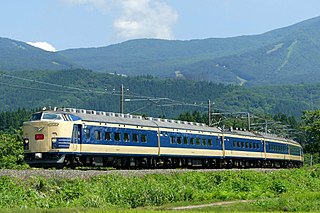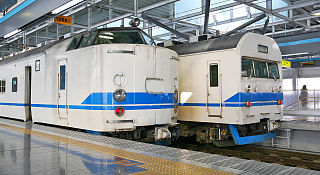
The 103 series is a DC electric multiple unit (EMU) commuter train type introduced in 1963 by Japanese National Railways (JNR), and currently operated by West Japan Railway Company and Kyushu Railway Company. They were also operated by East Japan Railway Company and Central Japan Railway Company.

The 117 series is a Japanese suburban electric multiple unit (EMU) train type introduced in 1979 by Japanese National Railways (JNR), and currently operated by West Japan Railway Company (JR-West). The train type was operated by Central Japan Railway Company from 1987 until 2013. A total of 216 cars were manufactured. When JNR was privatized and divided into the individual JR Group companies, JR Central received 72 cars, while JR-West took possession of 144.

The 113 series is a Japanese suburban electric multiple unit (EMU) train type introduced in 1963 by Japanese National Railways (JNR), currently operated by West Japan Railway Company (JR-West) and Shikoku Railway Company, and formerly also operated by East Japan Railway Company and Central Japan Railway Company.

The 63 series (63系) was a commuter electric multiple unit operated by Japanese Government Railways (JGR) and Japanese National Railways (JNR). The cars that made up the 63 series were numbered as MoHa 63, SaHa 78 and KuHa 79.

The Sakuma Rail Park was an open-air railway museum located next to Chūbu-Tenryū Station on the Iida Line in Hamamatsu, Shizuoka, Japan. It was operated by Central Japan Railway Company, and was opened on 21 April 1991. The museum closed on 1 November 2009 in preparation for the move to a new SCMaglev and Railway Park in Nagoya in 2011.

The SCMaglev and Railway Park is a railway museum owned by Central Japan Railway Company in Nagoya, Japan. The museum opened on 14 March 2011.

The KuMoHa 12 (クモハ12形) was a class of electric multiple unit (EMU) railroad cars formerly used by the Japanese National Railways (JNR). These are EMU power cars of 17-meter (56 ft) length with a driver's cab at each end, three passenger doors on each side, and lengthwise bench-type passenger seating. The cars themselves were built in the later 1920s and 1930s for JNR's predecessor, the Japanese Government Railways (JGR), but the class, originally named MoHa 12 (モハ12形), was established on 1 June 1953 by a JNR revision of its rolling stock classification regulations. In June 1959, a new JNR classification revision assigned the code KuMo (クモ) to all cab-equipped power cars, giving the KuMoHa 12 class its present name.

The 581/583 series (581/583系) were limited express electric multiple unit (EMU) train types introduced in 1967 by Japanese National Railways and later operated by East Japan Railway Company and West Japan Railway Company on the through services express Kitaguni and other special trains until 2017.

The 165 series was an express electric multiple unit (EMU) train type introduced in 1963 by Japanese National Railways (JNR).

The 169 series (169系) was an express electric multiple unit (EMU) train type introduced in 1969 by Japanese National Railways (JNR), and later operated by East Japan Railway Company until 1996 and by Shinano Railway in Nagano Prefecture until 2013. The 169 series was developed from the 165 series EMUs.

The 419 series was an electric multiple unit (EMU) train type introduced in 1985 by Japanese National Railways (JNR), and later operated by West Japan Railway Company (JR-West) on local services along the Japan Sea coast of Japan until March 2011. They were converted from former 583 series sleeping car EMUs in the 1980s.

The 381 series is a tilting DC electric multiple unit (EMU) train type introduced in 1973 by Japanese National Railways (JNR), and currently operated by West Japan Railway Company (JR-West), and formerly also operated by Central Japan Railway Company in Japan.

The 715 series (715系) was an electric multiple unit (EMU) train type introduced in February 1984 by Japanese National Railways (JNR), and later operated by East Japan Railway Company and Kyushu Railway Company on local services in Japan. They were converted from former 581/583 series sleeping car EMUs.

The 119 series (119系) was a DC electric multiple unit (EMU) train type which was operated on local services in Japan by Japanese National Railways (JNR) and later by Central Japan Railway Company between 1983 and March 2012.

The 105 series is a DC electric multiple unit (EMU) train type formerly operated by Japanese National Railways (JNR), and currently operated on local services by West Japan Railway Company in Japan since 1981. They were also formerly operated by East Japan Railway Company.

The 301 series (301系) was an electric multiple unit (EMU) train type introduced in 1966 by Japanese National Railways (JNR), and later operated by East Japan Railway Company on Chuo-Sobu Line and Tozai Line subway through-running services in Tokyo, Japan, until 2003.

The 123 series is a single-car electric multiple unit (EMU) train type introduced in 1986 by Japanese National Railways (JNR), and later operated by East Japan Railway Company, Central Japan Railway Company, and West Japan Railway Company (JR-West).

The 717 series (717系) was a Japanese AC electric multiple unit (EMU) train type first introduced by Japanese National Railways (JNR) in March 1985 and later operated on local services by the East Japan Railway Company and Kyushu Railway Company. The units were formed by converting former AC/DC dual-voltage 451 series, 453 series, 457 series, and 475 series EMUs.

The 413 series is a Japanese dual-voltage electric multiple unit (EMU) train type first introduced by Japanese National Railways (JNR) in March 1986, and later operated on local services on the Hokuriku Main Line by the West Japan Railway Company (JR-West) from 1987 and also by the third-sector railway operating company Ainokaze Toyama Railway from March 2015. The units were built by re-using the underframes, bogies and electrical equipment from former 471 series and 473 series express-type EMUs with new suburban type bodies based on the design of the 417 series EMUs introduced in 1978.

The 455 series is a Japanese dual-voltage electric multiple unit (EMU) train type introduced by Japanese National Railways (JNR) on express services in 1965 and later operated by East Japan Railway Company, West Japan Railway Company (JR-West), and Kyushu Railway Company.






















